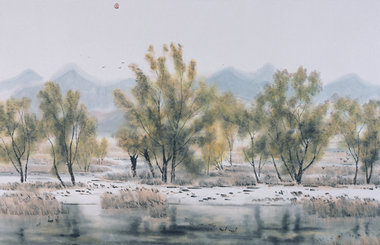Wandering in the Old Town
By Wang Shanshan ( China Daily ) Updated: 2015-07-11 08:15:44
 |
|
The old town in Graz is one of the best preserved city districts in Europe. In 1999, it was added to the prestigious UNESCO World Heritage List. [Photo by Wang Shanshan/China Daily] |
Bus No 1 of Graz is the most convenient tourist bus that I have ever taken. It connects nearly all the major attractions in the second largest city of Austria, including the Eggenberg Palace, several world-class museums, the Old Town of Graz, and an ancient fortress.
Among these attractions, the Old Town of Graz is one of the best-preserved city centers in Central Europe. It was added to the UNESCO list of World Cultural Heritage Sites in 1999.
Graz became an important commercial center in the 12th century. Later, it was the capital city of the Inner Austrian line of the Habsburg family, whose rule in Austria began in 1279. Some buildings in its Old Town are in the style of the Habsburg era.
Other buildings are more Italian than Central European. The city's design and planning were, in the 16th century, controlled by Italian Renaissance architects and artists.
Luckily, the elaborate Old Town was not seriously hit during World War II (1937-45). Only a small number of the buildings in Graz were destroyed by Allied bombing, and they were mainly outside the Old Town.
The Old Town is a great place to hang around for a day or two. There are hundreds of shops, including both outlets of famous brands and creative studios of individuals. We enjoyed an Italian lunch, and had authentic, delicious dishes at a Chinese restaurant for dinner.
There are few Chinese tourists, but the ice-cream man, who handed me a cone topped with a dark chocolate and a rum-and-vanilla ball, said in perfect Chinese: "liang kuai pa", which means 2.8 euro. It turned out that he was learning Chinese at the Confucius Institute at the University of Graz.
The most impressive shopping sight in the Old Town is a whole street lined with shops selling leather products. We lingered in the dozens of leather shops, among bags, belts, hats, shoes, suitcases and everything else made of leather, for two hours. Finally, my friend bought a mini-sized made-in-Italy leather handbag for less than 30 euro.
Taking Bus No 1 at the center of the Old Town, we arrived at the foot of Schlossberg, also known as the Castle Hill. A cable car, with glass windows, took us to the hilltop. The price of the ticket for the cable car ride is included in the one-day bus pass.
The Clock Tower atop the hill, dating from the 13th century, is the landmark of Graz. It still works. The hill was a mighty fortress, and when Napoleon won over the Habsburgs of Austria in 1809, he had the fortress demolished. The residents of Graz paid the French a huge ransom and saved the tower from the same fate.
A major remnant of the fortress is a former bastion that was used as a music venue. The bastion is about six meters into the ground, and its cells have become the audience area.
The hilltop restaurant serves great goulash, along with barbecued sausages and bread. We had a hot goulash soup in the chilly weather, sipped a glass of the local wine and enjoyed the stunning views over the medieval rooftops of the Old Town.
|
|
|
|
|
|
|
|

























 Raymond Zhou:
Raymond Zhou: Pauline D Loh:
Pauline D Loh: Hot Pot
Hot Pot Eco China
Eco China China Dream
China Dream China Face
China Face






